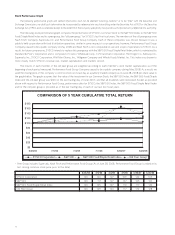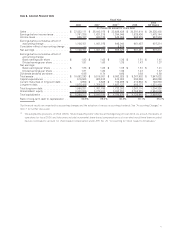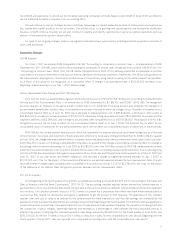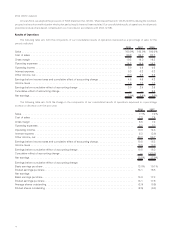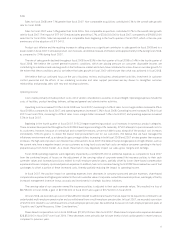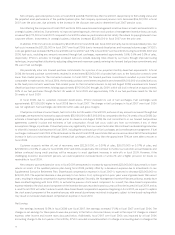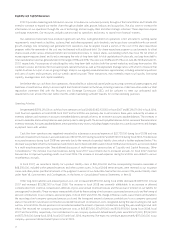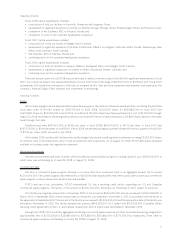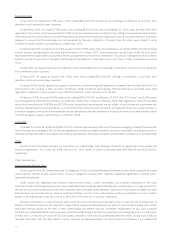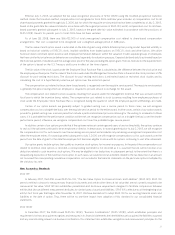Sysco 2008 Annual Report Download - page 43
Download and view the complete annual report
Please find page 43 of the 2008 Sysco annual report below. You can navigate through the pages in the report by either clicking on the pages listed below, or by using the keyword search tool below to find specific information within the annual report.
mitigate increased fuel costs by reducing miles driven, improving fleet consumption by adjusting idling time and maximum speeds, entering
into fixed price fuel purchase commitments and the use of fuel surcharges. In fiscal 2008, due to sustained increased diesel prices, our use of
fuel surcharges increased. Fuel surcharges were approximately $21,000,000 higher in fiscal 2008 over fiscal 2007.
In fiscal 2008, we recorded a provision of $22,284,000 related to additional amounts that we expect to be required to contribute to an
underfunded multi-employer pension plan and our withdrawal from a multi-employer pension plan. In fiscal 2007, we recorded a provision
of $4,700,000 related to our withdrawal from a multi-employer pension plan.
The increases in operating income in fiscal 2007 over fiscal 2006 were primarily due to gross margin dollars increasing at a faster pace
than expenses. Gross margin dollars increased 6.6% while operating expenses increased 5.4% in fiscal 2007 over fiscal 2006.
SYGMA Segment
SYGMA operating companies distribute a full line of food products and a wide variety of non-food products to certain chain restaurant
customer locations. SYGMA operations have traditionally had lower operating income as a percentage of sales than SYSCO’s other
segments.This segment of the foodservice industry has generally been characterized by lower overall operating margins as the volume that
these customers command allows them to negotiate for reduced margins. These operations service chain restaurants through contractual
agreements that are typically structured on a fee per case delivered basis.
Sales
Sales for fiscal 2008 were 4.4% greater than fiscal 2007. Non-comparable acquisitions contributed 0.3% to the overall sales growth rate
for fiscal 2008. Fiscal 2008 growth was generally due to product cost increases and sales to new customers. These increases were partially
offset by lost sales due to non-renewed customer agreements and lower case volumes due to difficult economic conditions impacting
SYGMA’s customer base.
Sales for fiscal 2007 were 6.0% greater than fiscal 2006.The impact of EITF 04-13 reduced sales growth by 2.7%, or $159,236,000, for
fiscal 2007 compared to a $42,560,000 reduction for fiscal 2006. Sales are reported on a comparable basis beginning in the fourth quarter
of fiscal 2007, which is the one-year anniversary of the adoption of EITF 04-13. Non-comparable acquisitions contributed 2.1% to the overall
sales growth rate for fiscal 2007. The remaining fiscal 2007 growth was due to sales to new customers and sales growth in SYGMA’s
existing customer base related to increased sales at existing locations as well as new locations added by those customers. In addition,
certain customers were transferred from Broadline operations to be serviced by SYGMA operations, contributing to the sales increase.
Operating Income
Operating income in fiscal 2008 decreased as compared to fiscal 2007. In fiscal 2008, SYGMA expensed $5,587,000 related to the
write-off of software development costs . In addition, some of SYGMA’s customers have experienced a slowdown in their business resulting
in lower cases per delivery and therefore reduced gross margin dollars per stop. SYGMA also experienced increased fuel costs of
$8,888,000 although it was able to partially offset these costs through increases in the fees charged to customers including fuel surcharges
and reducing expenses. Fuel surcharges were approximately $6,000,000 higher in fiscal 2008 over fiscal 2007. Expense reductions were
accomplished by consolidating regional offices, reducing headcounts and not renewing unprofitable customer contracts.
The increase in operating income in fiscal 2007 was due to several factors, including sales growth, increased margins and improved
operating efficiencies, partially offset by costs of labor increases and auto liability related expenses. In addition, the transfer of customers
from Broadline operations referred to above also contributed to the increase in operating income.
Other Segment
“Other” financial information is attributable to our other operating segments, including our specialty produce, custom-cut meat and
lodging industry products and a company that distributes to international customers. These operating segments are discussed on an
aggregate basis as they do not represent reportable segments under SFAS No. 131.
On an aggregate basis, our “Other” segments have a lower operating income as a percentage of sales than SYSCO’s Broadline segment.
SYSCO has acquired the operating companies within these segments in relatively recent years.These operations generally operate in a niche
within the foodservice industry.These operations are also generally smaller in sales and scope than an average Broadline operation and each
of these segments is considerably smaller in sales and overall scope than the Broadline segment. In the aggregate, the “Other” segment
represented approximately 9.7% and 7.3% of SYSCO’s overall sales and operating income in fiscal 2008, respectively.
Operating income increased 3.3% for fiscal 2008 over fiscal 2007. The increase in operating income was generated primarily by
improved results in the specialty produce and the lodging industry segments offset by reduced sales and operating income in the custom-cut
meat segment.
Operating income increased 6.2% for fiscal 2007 over fiscal 2006. The increase in operating income was generated by improved
results in each of the other segments and acquisitions.
19



